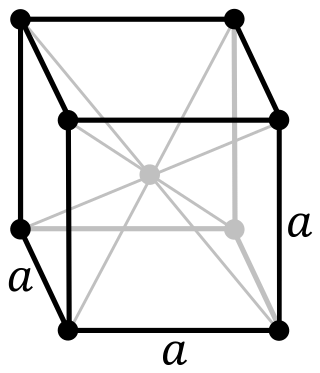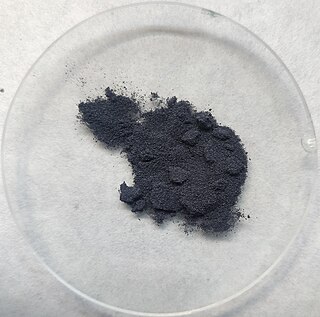Molybdenum oxychloride may refer to:
- Molybdenum oxytetrachloride, MoOCl4
- Molybdenum dichloride dioxide, MoO2Cl2
The molybdenum oxychlorides are a subset of metal oxyhalides.
Molybdenum oxychloride may refer to:
The molybdenum oxychlorides are a subset of metal oxyhalides.

Molybdenum is a chemical element with the symbol Mo and atomic number 42 which is located in period 5 and group 6. The name is from Neo-Latin molybdaenum, which is based on Ancient Greek Μόλυβδος molybdos, meaning lead, since its ores were confused with lead ores. Molybdenum minerals have been known throughout history, but the element was discovered in 1778 by Carl Wilhelm Scheele. The metal was first isolated in 1781 by Peter Jacob Hjelm.

Seaborgium is a synthetic chemical element with the symbol Sg and atomic number 106. It is named after the American nuclear chemist Glenn T. Seaborg. As a synthetic element, it can be created in a laboratory but is not found in nature. It is also radioactive; the most stable known isotope, 269Sg, has a half-life of approximately 14 minutes.
MOS or Mos may refer to:
Moly may refer to:
Molybdenum trioxide describes a family of inorganic compounds with the formula MoO3(H2O)n where n = 0, 1, 2. These compounds are produced on the largest scale of any molybdenum compound. The anhydrous oxide is a precursor to molybdenum metal, an important alloying agent. It is also an important industrial catalyst. It is a yellow solid, although impure samples can appear blue or green.

Sodium molybdate, Na2MoO4, is useful as a source of molybdenum. This white, crystalline salt is often found as the dihydrate, Na2MoO4·2H2O.

Molybdenum disilicide (MoSi2, or molybdenum silicide), an intermetallic compound, a silicide of molybdenum, is a refractory ceramic with primary use in heating elements. It has moderate density, melting point 2030 °C, and is electrically conductive. At high temperatures it forms a passivation layer of silicon dioxide, protecting it from further oxidation. The thermal stability of MoSi2 alongside its high emissivity make this material, alongside WSi2 attractive for applications as a high emissivity coatings in heat shields for atmospheric entry. MoSi2 is a gray metallic-looking material with tetragonal crystal structure (alpha-modification); its beta-modification is hexagonal and unstable. It is insoluble in most acids but soluble in nitric acid and hydrofluoric acid.

Tungsten hexachloride is the chemical compound of tungsten and chlorine with the formula WCl6. This dark violet blue species exists as a volatile solid under standard conditions. It is an important starting reagent in the preparation of tungsten compounds. Other examples of charge-neutral hexachlorides are rhenium(VI) chloride and molybdenum(VI) chloride. The highly volatile tungsten hexafluoride is also known.

Molybdenum tetrachloride is the inorganic compound with the empirical formula MoCl4. The material exists as two polymorphs, both being dark-colored paramagnetic solids. These compounds are mainly of interest as precursors to other molybdenum complexes.
Molybdenum oxide may refer to:

Molybdenum hexafluoride, also molybdenum(VI) fluoride, is the inorganic compound with the formula MoF6. It is the highest fluoride of molybdenum. It is a colourless solid and melts just below room temperature and boils in 34 °C. It is one of the seventeen known binary hexafluorides.
Molybdenum chloride can refer to:
A molybdenum cofactor is a biochemical cofactor that contains molybdenum.

Molybdenum(II) acetate is a coordination compound with the formula Mo2(O2CCH3)4. It is a yellow, diamagnetic, air-stable solid that is slightly soluble in organic solvents. Molybdenum(II) acetate is an iconic example of a compound with a metal-metal quadruple bond.
Moca, MoCA, or MOCA may refer to:
Tribromide is the anion with the chemical formula Br3−, or salts containing it:

Molybdenum(V) fluoride is an inorganic compound with the formula MoF5. It is a hygroscopic yellow solid. Like most pentafluorides, it exists as a tetramer.
Molybdenum fluoride can refer to

Molybdenum dichloride dioxide is the inorganic compound with the formula MoO2Cl2. It is a yellow diamagnetic solid that is used as a precursor to other molybdenum compounds. Molybdenum dichloride dioxide is one of several oxychlorides of molybdenum.
Molybdenum oxyfluoride may refer to: